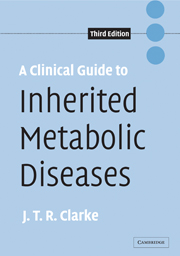Book contents
- Frontmatter
- Contents
- Reviews of first edition
- Reviews of second edition
- List of tables
- List of figures
- Preface
- 1 General principles
- 2 Neurologic syndrome
- 3 Metabolic acidosis
- 4 Hepatic syndrome
- 5 Cardiac syndromes
- 6 Storage syndrome and dysmorphism
- 7 Acute metabolic illness in the newborn
- 8 Newborn screening
- 9 Laboratory investigation
- 10 Treatment
- Index
Preface
Published online by Cambridge University Press: 10 September 2009
- Frontmatter
- Contents
- Reviews of first edition
- Reviews of second edition
- List of tables
- List of figures
- Preface
- 1 General principles
- 2 Neurologic syndrome
- 3 Metabolic acidosis
- 4 Hepatic syndrome
- 5 Cardiac syndromes
- 6 Storage syndrome and dysmorphism
- 7 Acute metabolic illness in the newborn
- 8 Newborn screening
- 9 Laboratory investigation
- 10 Treatment
- Index
Summary
In this enlarged third edition of A Clinical Guide to Inherited Metabolic Diseases, I have preserved the basic, clinical approach first developed in the first edition of the book. However, advances in many fields over the past 5 years have made it necessary to add significantly in some areas, such as mitochondrial disorders and the congenital disorders of glycosylation. The challenge continues to be to find ways to translate discoveries made in research laboratories, which understandably focus on biochemical and genetic principles, into a clinically relevant format organized in a way to facilitate the early recognition of the disorders by clinicians. For example, inherited defects in mitochondrial electron transport (ETC) may present as neurological syndromes (encephalopathy, myopathy, movement disorder), cardiac syndrome (cardiomyopathy), hepatic syndrome, metabolic acidosis, or catastrophic illness in the newborn. The challenge has been to develop and present a clinical approach to mitochondrial ETC defects without being unnecessarily repetitious. The chapter on ‘Laboratory investigation’ is important in this respect because it provides an approach to the transition in thinking between the recognition of various clinical signs and the biochemical and genetic investigation of possible causes of disease. By the very nature of laboratory investigation, it is also organized biochemically, which draws together the consideration of all those disorders presented in various different chapters as clinical problems. The book should, therefore, be viewed as a series of clinical chapters, which overlap in terms of biochemical and genetic organization and content in the chapter on ‘Laboratory investigation’.
Information
- Type
- Chapter
- Information
- A Clinical Guide to Inherited Metabolic Diseases , pp. xix - xxPublisher: Cambridge University PressPrint publication year: 2005
